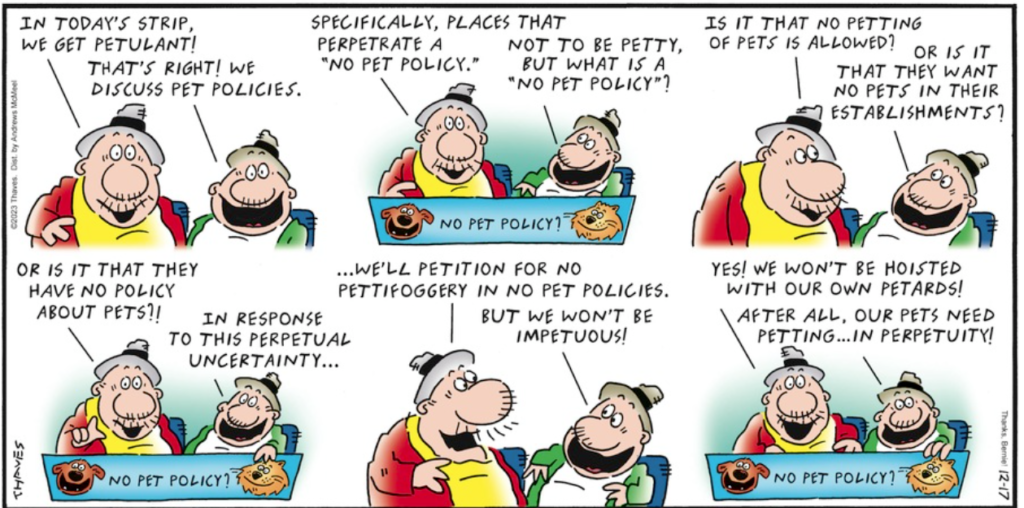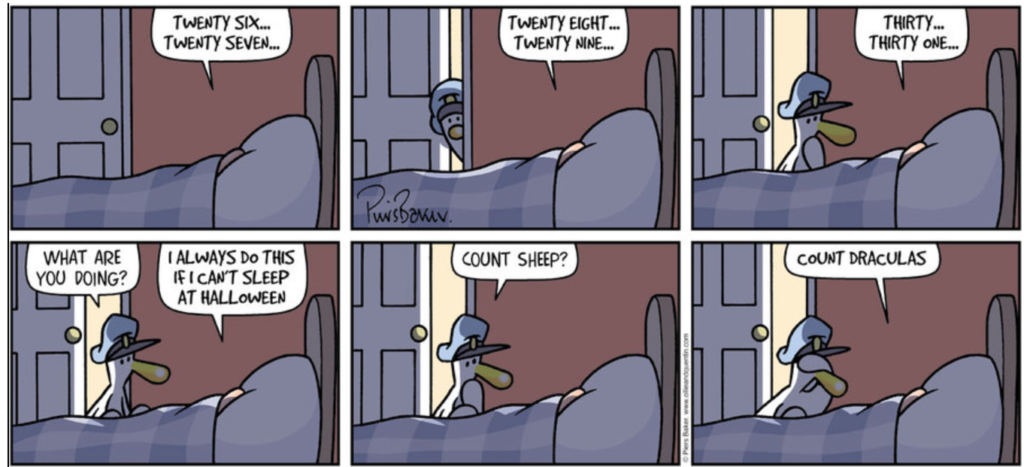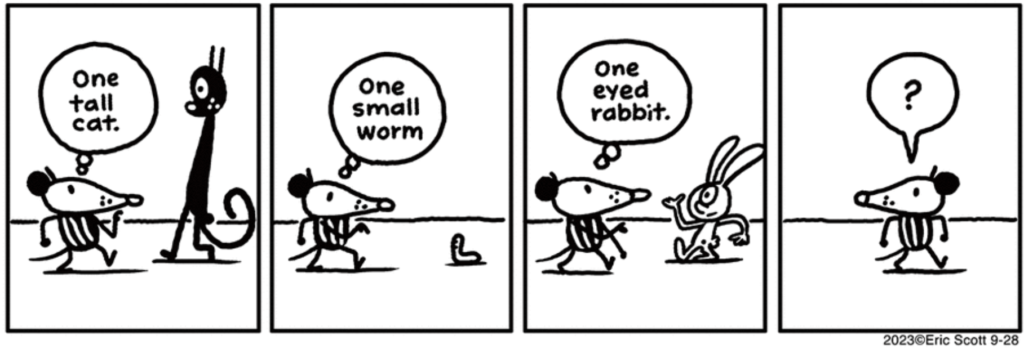A Good Example of why Hyphens are Important
One function of hyphens is to tie two words together into what we call a compound adjective. The difference in which word (or words) another word modifies can be significant. Lots of humor in this strip, but read the label on the sign.
Now look at the first panel in the bottom row. He reads the sign correctly! Without the hyphen, “no” modifies “pet policy.” If you have a policy that forbids pets, you have to say “no-pet policy.”
PS—I just ran into this. Same lesson, only about the space between words. I found it on Facebook

Subscribe to this blog's RSS feed
How Not to Write Written-out Numbers
This comic is completely wrong. Nice pun at the end, though.
Generally we write out the single-digit numbers, and we write the digits of longer numbers. But sometimes we want to spell out a longer number. The correct way to spell out a two-digit number is to put a hyphen between the spelled-out digits (and use “and” for decimals). So 27 is twenty–seven when you write it out.
Even longer numbers are written out as separate words, so 275 is two hundred seventy-five. (Not two hundred and seventy-five, because “and” means decimal point.)
Another Hyphen Lesson
In english, adjectives normally belong right before the word they modify, but sometimes we put two words together to make a compound adjective. Then we need to hyphenate!
See? In the first two, each adjective separately modifies the last word. In the third panel, though, we have a compound adjective, so it should have a hyphen. Except then the comic wouldn’t be as funny.
My Kind of News Article
And I don’t even do spectator sports! First the text:
MiLB team wants a grammatically correct name
- Winston-Salem, North Carolina’s professional baseball team, like so many Minor League Baseball teams, bears a hyperlocal name. The Winston-Salem Dash is a nod to the name of the city itself, formed when two neighboring towns merged in 1913.
- The issue of the team’s name arose a few weeks ago when team General Manager and President Brian DeAngelis called upon Mayor Allen Joines to formally change the name of Winston-Salem to “Winston Dash Salem.” Joines had a swift response: “That’s grammatically incorrect. The dash is actually a hyphen.”
- The Dash consulted with experts and confirmed the mayor was correct: A dash interrupts while a hyphen connects. So for its May 6 home game themed a salute to Winston-Salem, the team’s name will temporarily change to the Winston-Salem Hyphens, reports Lillian Johnson at the Triad Business Journal. New merchandise, including hats and T-shirts, are already on sale online. Game-day jerseys will be auctioned off, with all proceeds going towards charity.
I distinguish between hyphens (short) and dashes (long) all the time (see the search box in the upper right), so I gotta like this article. Here’s a picture of their T-shirts:

Bolt, the mascot of the Winston-Salem Dash, shows off the team’s new merchandise to go with its new name, the Winston-Salem Hyphens.
Plagarized Punctuation Guide #1
I give credit, though. This is from https://allthingsfreelancewriting.com/blog/punctuation-guide/
The article is just too good not to share. More next time.
Dashes may seem pretty simple and straightforward. But did you know there are three main types — the en dash, em dash, and triple-em dash? Here, we’ll cover all three (plus the hyphen which can be easily confused with a dash).
- hyphen (-)
- en dash (–)
- em dash (—)
- triple em dash (— — —) [This one is new to me]
Hyphens
The hyphen (-) is not technically a dash, but it looks like a short one.
How to type a hyphen
Hyphens are easy to type as they have a dedicated key on U.S. keyboards that’s shared with the underscore.
When to use hyphens
Hyphens should be used when:
- A word has more than one syllable and is divided between two lines.
- You want to spell out a word letter by letter in your writing (g-o-o-d-b-y-e).
- You need to join two or more words to form compound adjectives before a noun (kind-hearted person).
- Two vowels make a word awkward (pre-elect).
- A lack of a hyphen would cause the word to be misread (re-creation).
- You write compound numbers (thirty-two).
- You want the text to be read as a stutter (I’m s-s-s-sorry).
- You use certain prefixes like all- and self- (self-sufficient).
- You use certain suffixes like -elect (president-elect).
En dashes
The en dash (–) is a dash that’s the length of the letter “n.”
How to type an en dash
You can type an en dash on a Mac by pressing the “option” key and the hyphen key at the same time. On Windows, press the “Alt” key, type 0150, and release the “Alt” key.
When to use en dashes
En dashes are used to replace the words “to” and “through” in ranges of numbers, spans of time, and scores. For example:
- I read chapters 1–3 of my book.
- The seasonal resort is open April–October.
- The Eagles are winning 21–19.
They’re also used if you’re writing a compound adjective and a hyphen doesn’t work. This often happens when the compound adjective is a proper noun. Here’s an example:
- She’s a Pulitzer Prize–winning journalist.
You wouldn’t put a hyphen between Pullitzer and Prize so you add the en dash which tells the reader the two preceding words are part of the compound adjective.
Em dashes
Now, for the favorite of many writers — the em dash. Em dashes are longer dashes that are the length of the letter “m.”
How to type an em dash
To type an em dash on a Mac, press “option+shift+hyphen key” at the same time. Note, some mac keyboards have an “alt” key instead of the “option” key. On a PC, press “control+alt+hyphen key.”
If you have trouble, you can always head over to Google, search for em dash, and copy and paste the mark into your document.
When to use em dashes
Em dashes are a very versatile type of punctuation that can be used to replace other marks, such as parentheses or commas. They work well when you want to set information apart, mark an abrupt turn in a sentence, or expand on something without creating a run-on sentence.
Here are some examples:
- My favorite dress — which had beautiful floral appliques all over it — was destroyed in the wash.
- I love to cook — I’m always trying new recipes.
- We went to the lake and had a great day but — never mind, I don’t want to talk about it.
3-em dashes
The 3-em dash is created by typing the em dash three times in a row with spaces between each em dash (— — —)
When to use 3 em dashes
The 3-em dash is commonly used by journalists to signal that words have been left out or names have been omitted — like names of sources who don’t want to go on the record.
It can also be used to cite works by the same author in a Chicago format paper.



